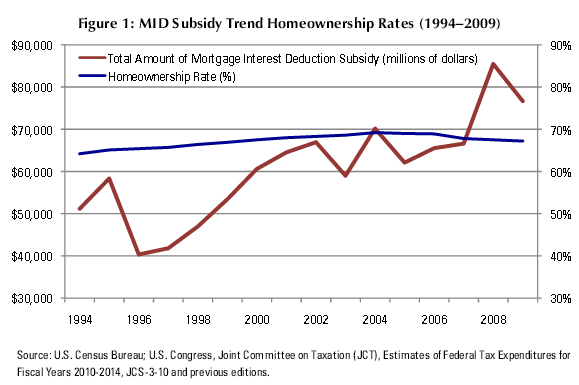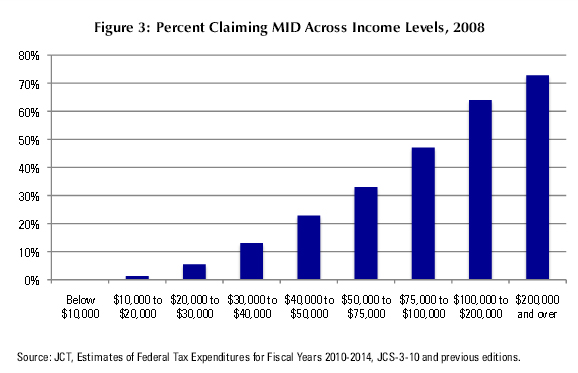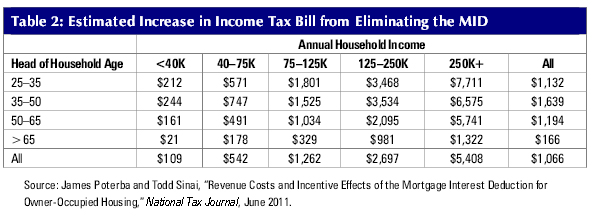The mortgage interest deduction (MID) is never left alone for very long. In Unmasking the Mortgage Interest Deduction: Who Benefits and by How Much? Economists Dean Stansel and Anthony Randazzo lay out their arguments for eliminating the popular deduction from the tax code. Written for the libertarian Reason Foundation, the article examines the history and reasoning behind MID, looks at the financial impact on individuals, the housing market, and tax collections, and presents alternatives which they say would more evenly distribute tax benefits and help the economy.
MID, the authors say, is the largest of the complicated deductions, credits, and loopholes that fill the U.S. federal income tax code. According to the Internal Revenue Service (IRS) itemized deductions excluded $1.2 trillion in income from the 2011 tax base, 14 percent of total adjusted gross income (AGI). The MID accounted for 35 percent of these deductions.
The paper says all taxes on income create distortions in economic decision making. The more something is taxed, increasing its relative cost, the more individuals will consume a relatively cheaper substitute. This reduces efficiency, creating excess burden or deadweight loss. "The least distortionary income tax system is the one with the broadest possible tax base and the lowest possible marginal tax rates. Consider that if the tax base was broadened to include the $1.2 trillion in itemized deductions for 2011, the average tax rate could be reduced by nearly one-fifth, from 17.3 percent of taxable income to 14.2 percent."
Stansel and Randazzo say such a reduction in marginal tax rates would directly increase the reward for productive (income- generating) activity. As a result, closing loopholes such as the MID and lowering overall rates would likely lead to a more prosperous economy with higher economic output and incomes.
The MID is as old as the income tax; the very first tax form allowed taxpayers to deduct all interest paid on debt. Initially few people paid taxes so this deduction affected very few and the distortions were small. During World War II, however, taxes were raised and exemptions and tax brackets lowered so more people paid taxes and the importance of this deduction increased as did the distortions. The 1986 revision of the tax code eliminated all interest payments on personal debt except for the MID which, the authors say was by then so popular politicians feared cutting it.
One defense of MID is that is helps increase homeownership which is usually viewed as a societal good. But the authors maintain the MID fairly ineffective at this. Renter households that would prefer to own "if they had just a bit more financial flexibility," tend to be low income and thus less likely to itemize their deductions. So, instead of increasing the homeownership rate, the MID increases the amount spent on housing by consumers "who would choose to own anyway, subsidizing spending on housing rather than homeownership." If the MID had a significantly positive effect on homeownership, they contend we would expect to see a faster and continuous increase in homeownership, rather than a gradual increase and subsequent decline.

The MID encourages consumers to use debt rather than their own assets to finance home purchases. This creates a distortion in how financial capital is allocated, which leads to greater amounts of mortgage debt. The paper frequently quotes economists James Poterba and Todd Sinai who estimate taxpayers could reduce their mortgage debt by nearly 30 percent by using other financial paper assets, (savings or brokerage accounts) to pay off loans. If all non-housing assets, such as retirement accounts, trusts, and annuities, were liquidated to pay off mortgage debt, Poterba and Sinai estimate that the reduction could be 70 percent.
Furthermore, the marginal effective tax rate for owner-occupied housing in 2003 was only 2 percent, compared to 18 percent for noncorporate investment and 32 percent for corporate investment. By creating favorable tax treatment for housing compared to other investments, the mortgage interest deduction encourages individuals to over-invest in housing, contributing to housing bubbles. The Federal Reserve Bank of Philadelphia estimate that government incentives for homeownership, including the MID, have skewed distribution of resources so much that the American housing stock is 30 percent larger than it otherwise would be.
This over-investment means less capital is put toward productive assets in the rest of the economy, like machines and equipment used to produce goods and services. If there are fewer productive assets, there will be less economic growth and a lower standard of living.
In 2011, only about 32 percent of income tax returns filed with the IRS contained itemized deductions and about 21 percent of itemizers do not take the MID. The percentage of taxpayers claiming a MID has been relatively stable at between 21 and 26 percent since 1991.
Only a small portion of taxpayers with incomes below $50,000 claim the mortgage interest deduction while about two-thirds of those with incomes above $100,000 do so because homeownership rates are much lower in lower- income groups and because lower-income taxpayers often benefit more from taking the standard deduction. Even when they do itemize, the incremental benefit above the standard deduction is often quite small. Also, higher income taxpayers tend to benefit more because they face higher marginal tax rates and tend to have larger mortgages.

In a 1990 revision to the tax code the so-called Pease limits were introduced which limited the MID by the amount by which a taxpayers AGI exceeds a certain threshold. These limits were gradually eliminated between 2006 and 2010 but were reintroduced in 2013 as part of the agreement to avert the "fiscal cliff." The current threshold is $300,000 for joint and $250,000 for single filers. This threshold will be indexed to inflation in future years. The limits reduce itemized deductions by 3% of the amount by which AGI exceeds the threshold.
After the phase-out of the Pease limits began the percentage of the total savings from the mortgage interest deduction that went to taxpayers with AGI of $200,000 and above increased from 28.1% in 2005 to 34.6% in 2012. In addition, the percentage of the total number of returns claiming the MID that were filed by taxpayers with AGI of $200,000 and over increased from 8.4% in 2005 to 13.8% in 2012. Now that the Pease Limits are being reintroduced for 2013, they will reduce the itemized deductions (including the MID) of upper-income taxpayers, so the distribution of the benefit of the MID should become somewhat less skewed toward the highest income bracket. However, since the limits will only apply to those with incomes above $300,000 (for married taxpayers; $250,000 for singles), we would expect any such change to be quite small.
According to the IRS, the average MID claimed in 2011 was $10,660 per return. At the 2011 average tax rate of 12% of adjusted gross income, the potential tax savings was about $1,275 but this substantially overstates the effect of the MID. First, without the MID many taxpayers would take the standard deduction so the true influence of the MID is the amount by which it exceeds the standard deduction which would result, in the example above, to a tax savings of $792.
The authors broke up taxpayers into income brackets and used the combined data to show how many taxpayers actually claim an MID and what the relative values are of the deduction's benefit. Higher income individuals pay the largest share of the taxes and claim the largest share of the mortgage interest deductions. Figure 6 measures the estimated tax savings from the mortgage interest deduction in dollars, indicating that the largest benefit goes to upper income taxpayers. On a percentage basis however those with incomes between $30,000 and $40,000 save 1.7 percent. Taxpayers with incomes above $100,000 save 1.4 percent.

The MID benefit also varies by age, peaking at t $1,639 in the 35-to-50-year-old range and nearly disappearing for those over 65 ($166). Younger households typically have more mortgage debt, as they have not had time to pay down much of the principal, and most of each payment goes toward interest.
The benefits also varies by geographic locations with the biggest benefits going to homeowners in Washington, D.C., Hawaii, California, New York, Massachusetts, Connecticut, and New Jersey, with benefits per owner- occupied unit exceeding $8,000 in each of those high-income, high-tax states. Only 16 states were above the national average of $6,024.31
The benefits are similarly skewed toward large areas with high incomes, taxes, and housing prices, primarily in California and the Northeast corridor. In fact, just three large metro areas-New York-Northern New Jersey, Los Angeles- Riverside-Orange County, and San Francisco-Oakland-San Jose-received over 75 percent of the net positive benefits of the MID.
The MID may still have indirect effects on taxpayers who do not claim it through its influence on the housing market. For example, Lawrence Yun, chief economist for the National Association of Realtors (NAR), recently stated that getting rid of the MID would lower housing prices by 15 percent, and that this would be a negative effect on the market.
However, the authors say, higher house prices are not a good thing in and of themselves. An increase in nominal housing prices is only "good" if housing is viewed as a pure investment. In contrast, lower housing prices increase the affordability of homeownership but there are strong reasons view the ability of the MID to boost housing prices are substantially overstated.
With so few actually claiming the MID, the number whose demand is directly affected is relatively small but for those it effectively increases their after-tax income. Not all of these income benefits however are specifically spent on housing. Second, the MID can only be an effective subsidy for housing where it is highly visible to consumers so they can incorporate its value into their spending calculations. Third, the effects on pricing may be relatively small. A 1996 paper estimated that at most, the MID pushed housing prices up 10 percent assuming that the supply of housing remained absolutely stable. A 2911 study put the number at 3 to 6 percent.
One final way to consider how housing prices might be influenced is to consider how the MID benefit raises the amount of monthly mortgage payments that homeowners can afford to make. These estimated increases in consumer purchasing power because of the MID are fairly small, 2 percent on average and the actual increase would be less because the supply of housing is not fixed; i.e, homeowners selling their houses will adjust prices based on both the increase in the ability of buyers to pay more and on how many homes are currently on the market.
Advocates of the MID argue that eliminating it would negatively affect housing prices by as much as 15 percent but the authors conclude this affect would be relatively small, especially when compared to the decline in prices over the last few years. The reductions, moreover, would be beneficial to renters who seek to become homeowners. A decrease in sales would likely lower profits for realtors as well as those in the mortgage-lending and servicing industries, especially those who specialize in higher-priced houses.
If Congress chooses to address the mortgage interest deduction, it has three choices: a change in the MID to meet a specific policy goal, a full repeal of the MID, or the complete elimination of the MID with adjustments in the tax code to make it revenue neutral.
Option 1: A Partial Change of the MID
There is, the paper says, little reason to keep any favorable tax treatment for homeownership other than to promote a public policy goal of increasing it; a job for which the MID is particularly ineffective. The authors argue promoting homeownership is not appropriate policy and that trying to do so has been harmful to the economy.
Some have argued lowering the cap on deductible interest, others on substituting a tax credit and if Congress wishes to continue the a subsidy these changes would at least more effectively target it at those who are on the margin between renting and owning, rather than simply encouraging higher by those who are already homeowners. But like other recent tax policy attempts to jump start the housing market, it is likely that these types of changes would have unintended consequences and simply be a different means of creating distortions in economic decision making.
Option 2: Full Repeal of the MID. Housing prices might be lowered some but not enough to trigger another recession or foreclosure crisis and low income families are likely to be positively affected. The housing market, which as of this writing has a three- to four-year supply of homes available, would be able to clear some of its inventory, possibly boosting homeownership rates in the near term.
However, total elimination of the MID would increase taxes for the one-fourth of taxpayers who use the MID to lower their taxable income. Had the MID been fully eliminated in 2010, households earning between $100,000 and $200,000 a year would have seen a collective tax hike of $29.1 billion that year. Households making less than $100,000 would have paid $15.5 billion more in taxes. The extra revenue could help to reduce the deficit perhaps by as much as $68 billion (FY2012.)
Option 3: A Revenue-Neutral Elimination of the MID. The authors believe the most appropriate policy action would be a complete elimination of the mortgage interest deduction combined with reductions in marginal income tax rates to make the repeal revenue neutral. A full repeal of the MID would have broadened the tax base by $68.2 billion in 2011, and might have lowered the 2011 average tax rate of 18.2 percent to an average rate of 17.1 percent, without reducing the amount of revenue collected. Eliminating another large deduction, the real estate tax deduction which produced tax savings equal to about 36 percent of the MID would allow tax rates to be reduced another 2.2 percent for an overall reduction of 8.4 percent.
The authors acknowledge that the net effect for those who continue to itemize would still be an effective tax increase and the largest increase in dollar terms would be for those with the highest income. In percentage terms, the largest increase by far is for the lowest income taxpayer ($45,000). Those who continued to itemize in that lowest tax bracket would see their tax bill increase 29.1 percent. The smallest percentage increase (4%) is for those with the highest income. However, for the two lowest-income groups, less than half of taxpayers in that income range take the MID, so that net increase would not apply to most of them. For those who cease to itemize, eliminating the largest deduction actually reduces their tax bill because the affect of the tax rate reduction is larger than that of the MID elimination.
However, wealthy taxpayers could avoid part of the tax hike from a repeal of the MID by using other taxable assets to pay off (at least part of) their mortgage debt. This would mean reducing part of their taxable investment income, but it would also mean less debt.
The authors also suggest eliminating the MID for new mortgages but phasing it out for existing ones. Reducing the mortgage interest cap a certain percentage each year. This would soften the affect on taxpayers by allowing existing mortgage holders to retain the MID for a certain period of time.
As the authors see it, the benefits of eliminating MID would be to encourage financing by means other than excessive debt and reducing debt by 50 to 70 percent, reducing income tax rates by more than 6 percent without reducing the revenue collected; creating a more efficient tax system with fewer distortions and one that encourages economic growth.







